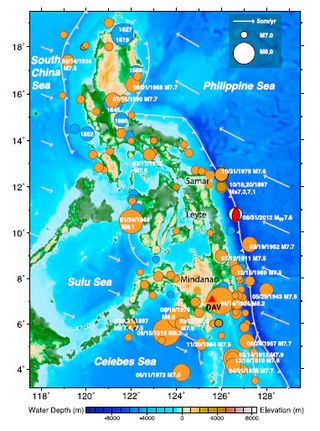
Aftershocks May Portend Major Philippine Earthquake

Aftershocks shook the Philippines for more than two weeks after a magnitude-7.6 quake rocked the region on Aug. 31, 2012. A team of seismologists monitoring the aftershocks and plotting their whereabouts noticed an odd pattern.
"Typically, if you locate aftershocks they sort of outline the fault that ruptures. This time they didn't," said Thorne Lay, a geophysicist at the University of California, Santa Cruz who was part of the team. "Instead they were shallower and had very different fault geometries."
The 7.6 quake happened at a fault within the Philippine Sea Plate, which is subducting beneath the Philippine Microplate. Some of the unusual aftershocks were so called "intraplate" ruptures, like the original quake, but happened at a shallower depth. And others of the unusual aftershocks were located west of the epicenter, within the Philippine Trench itself, where the plate is subducting. These are called interplate aftershocks because they happen at the boundary between two plates.
That segment of the trench hasn't seen a major earthquake in at least 400 years, but the shocks may be a sign that the plate boundary is linked to the intraplate rupture and that it is building up strain in preparation for a big one. No one will know until GPS equipment is installed and scientists collect more data, Lay said.
Eerily quiet
The Philippines are located in a very complex setting, geologically speaking. Four subduction zones surround the islands, and a series of faults crisscross the region. Overall, the area is quite seismically active, but the section of the Philippine Trench near the August 2012 quake has been eerily quiet.
That could mean one of two things, Lay told OurAmazingPlanet: "It's possible that the plate boundary isn't locked and it's just sliding along smoothly. On the other hand, it's possible that it's been building up strain for four centuries."
Sign up for the Live Science daily newsletter now
Get the world’s most fascinating discoveries delivered straight to your inbox.
Subduction zones like the Philippine Trench are responsible for the planet's largest earthquakes. With the two plates converging at a rate of about 2 inches (5 centimeters) per year at the trench, a lot of strain could be accumulating. The Philippine Trench subduction zone could produce a magnitude-9 quake if the entire plate boundary were to rupture at once, Lay said. [Video What Does Earthquake 'Magnitude' Mean?]
There is no evidence that that will happen — but there's also no evidence that it won't.
"Right now, we can't even really give a probability as to whether a rupture is likely," Lay said. Ideally, his team would like to collect GPS measurements along the entire boundary to track plate movements and strain accumulation. But setting up a monitoring system would require major resources, and the Philippines would need help from the international community.
Clues from other zones
There's not yet any data to point toward the likelihood of a major Philippine Trench quake, but there are clues from other subduction zones. The type of earthquake that caused the 7.6 temblor — a compressional-thrust earthquake under an oceanic trench and within a sinking tectonic plate — is quite rare, Lay explained. In the past, large earthquakes at the plate boundary have taken place decades after thrust events.
For example, before the magnitude-8.3 earthquake near the Kuril Islands (off the coast of Russia) in 2006, there was a 1963 quake foreshadowed by a thrust event in a sinking tectonic plate, similar to the recent Philippines event.
"The uncertain nature of seismic potential in the Philippine Trench means we have to look at all the stress indicators we can," Lay said. "Nature is providing us with clues that there is strain on the boundary, but we need to combine these with GPS measurements to confirm that's happening."
The team's findings were published Dec. 28 in the journal Geophysical Research Letters.
This story was provided by OurAmazingPlanet, a sister site to LiveScience. Follow OurAmazingPlanet on Twitter @OAPlanet. We're also on Facebook and Google+.
Most Popular


